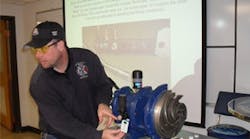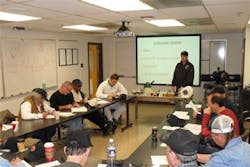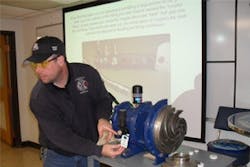This is the fourth and final installment of a series about one plant’s continuing journey to implement a world-class lubrication process.
Beer Guy here with my final update for you. We’ve accomplished a lot over the past year on our journey toward lubrication perfection, and I’m excited to share our latest successes and insights.
It’s been hectic here since we last checked in, especially in the midst of another busy brewing season. Phase 1 training is still going well, and I’ve seen a plant-wide awareness grow regarding lubrication best practices. The numbers say it all: Only three preventable rotating equipment failures occurred in 2013 — a five-fold reduction from past years. This is a significant improvement that can be directly attributed to greater awareness of lubrication best practices. More and more work orders have been generated by operations folks simply recognizing when something just doesn’t look right in the sight glass.
Phase 2: Lubrication management training underway
Figure 1. Employees appreciate and are responsive to the four-hour hands-on class that addresses the “how” and “why” of lubrication management.
With Phase 2 training kicking off recently, I’m hoping to see similar results and successes as we continue along our journey. So far, feedback on Phase 2 is good; folks really appreciate the hands-on aspect of this phase (Figure 1). People are especially responsive to the four-hour class that addresses the “how” and “why” of lubrication management. We go into great detail discussing why lubrication cleanliness, handling and monitoring are so important as well as the damage that contamination can have on the entire business operation.
I’ve been following up with crews after training to gauge the effectiveness of the class, and it’s apparent they aren’t only more aware and prepared to perform the activities, but they also understand the reasons for and the importance of each process. Our sample size of those who have completed Phase 2 training is relatively small, but it’s apparent how much more effective our training is now compared to even just a few years ago. Looking back, it’s scary to realize just how far off we were and how much we were at risk of equipment failures. Essentially, we were asking inadequately trained folks to perform lubrication tasks using improper equipment, and that was obviously putting us at major risk for failures.
The hands-on Phase 2 training will be beneficial for both skilled and inexperienced individuals, helping them to acquire the skills and know-how needed to perform all lubrication management tasks. With these improvements, we’ll experience fewer equipment failures. And standardization of our lubrication process and equipment are keys to long-term success.
Measuring the success of a new lubrication process
With Phase 2 training underway, my new focus is on auditing different departments to determine levels of improvement in our lubrication management process. I am asking the necessary questions to get the honest answers. Are we getting better? Is equipment cleaner and better maintained than before? Are better practices on display with sight glass conditions and low oil levels? Are approved lubrication containers in place in all areas?
To most accurately answer these questions, I pulled the work notifications from the previous year, where I wrote 244 notifications, 136 of those for low oil — some for the same machines over and over again. In the first two months of this year, I’ve only written 21 notifications, many of which are repeats from late last year. This is a 50% reduction already. And only six of the 21 notifications pertain to new conditions, so it’s apparent our efforts are working.
As I audit various departments, I notice that, in those areas where employees have already received training, the lubrication containers, grease guns, and jugs are cleaner, are better stored, and appear to be used properly. This drastic difference also makes it very easy to identify those departments that have not yet undergone the training. In departments where training has not yet occurred, I still see dirty sight glasses, low oil, improperly cared for containers and even some open caps on jugs sitting out on the floor. It’s no coincidence that these departments also have the most breakdowns and work orders for equipment. The good news is the area managers are now aware of the training, have tasked their staffs with getting up to par, and have approved implementing new lubrication equipment. The great news is this means we’re coming close to having a completely standardized lubrication management process.
These audits help us to identify and address some critical issues, and I feel we are well poised for the future — even with the inevitable hiccup every now and again. The most pressing question I’ll have to answer now is what will be my new gauge of success as our failures continue to decrease and our process continues to improve.
The journey onward toward lubrication perfection
Figure 2. Labels are popping up in even more departments that didn’t previously have them.
So, what’s next for us during this process? Once all our folks complete Phase 1 and Phase 2 training, we’ll implement Phase 3 training. In Phase 3, operators will be tested on all the necessary skills they’ve acquired in phases 1 and 2, ensuring we have an efficient and standardized process. I will continue to audit all departments and measure our progress, making sure we continue to improve and see a dramatic decrease in the number of work notifications and equipment failures.
As we continue on our journey toward lubrication perfection, I often reflect back to where we started. We’ve come a long way. One of the things I’m most pleased to see is OilSafe equipment utilized in most departments, with the correct tags and caps in their proper places on this new equipment. And I’m expecting to see brand-new color-coded grease guns, containers, and labels popping up in even more departments that didn’t previously have this equipment (Figure 2).
This is amazing to me, as even just six months ago I would get a call or an email with questions such as, “What lube do I use?” or “Where are the supplies I need?” People are becoming more self-sufficient and knowledgeable in lubrication management, knowing what to get, how to read the master lube list, how to coordinate the colors and symbols to the right product, and how to get the proper containers on their own. Don’t get me wrong — it’s not perfect all the time. However, I am asked less and less often to answer general questions and am instead looked to as an advisor. This gives me more time to focus on specific equipment needs and follow up on critical items.
I’m sure you’re wondering if we accomplished what we set out to do with this new process. We are well on our way; we have made great progress while implementing this world-class lubrication system. And these successes have made believers out of everyone, even those who initially doubted or resisted the change in our lubrication management process. We’ve seen an overall decrease in work notifications with reduced equipment failures and reduced instances of contamination, which has resulted in increased reliability and uptime. Our lubrication process is cleaner, more organized, and, most importantly, standardized, which has resulted in repeatable, measurable lubrication management.
As I’ve said before, the lubrication management process is continuous, and I still don’t see a time where every task will be complete. I believe that ongoing improvement is the key to success, and I’m excited to see how much better we can get in the future.
Thanks again for joining us on this journey. I hope that coming along with us as we implemented our new lubrication process has provided you with some useful information you can apply in your own facility or program. Cheers.



